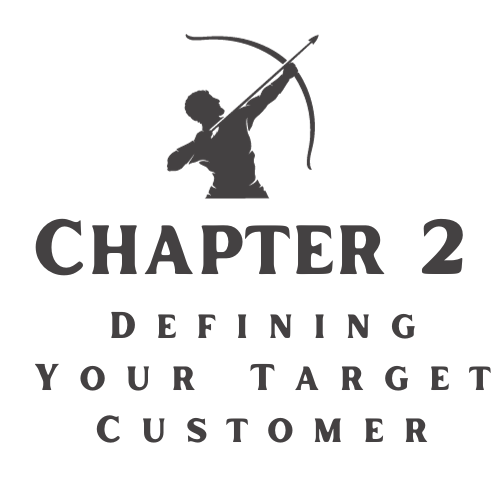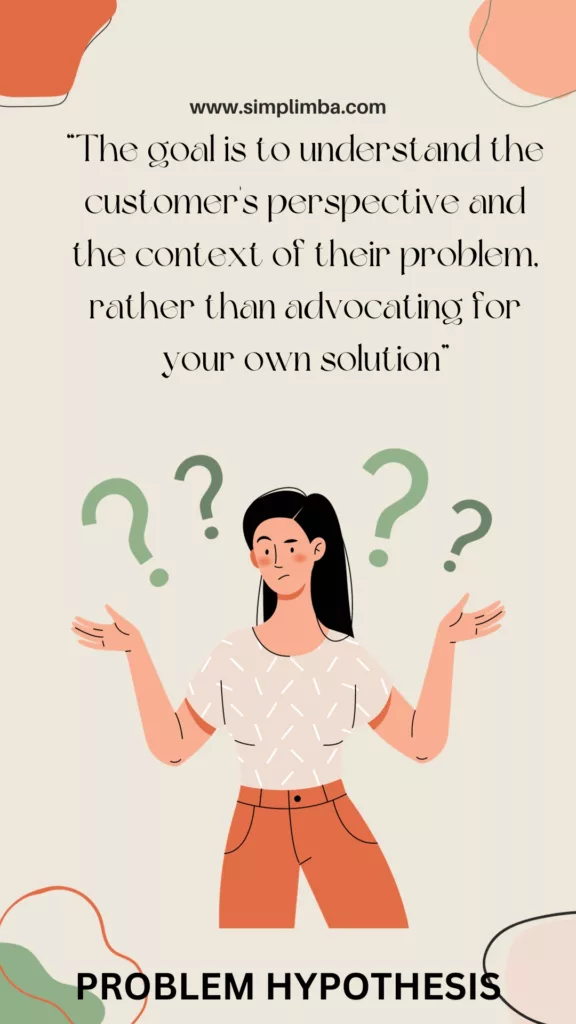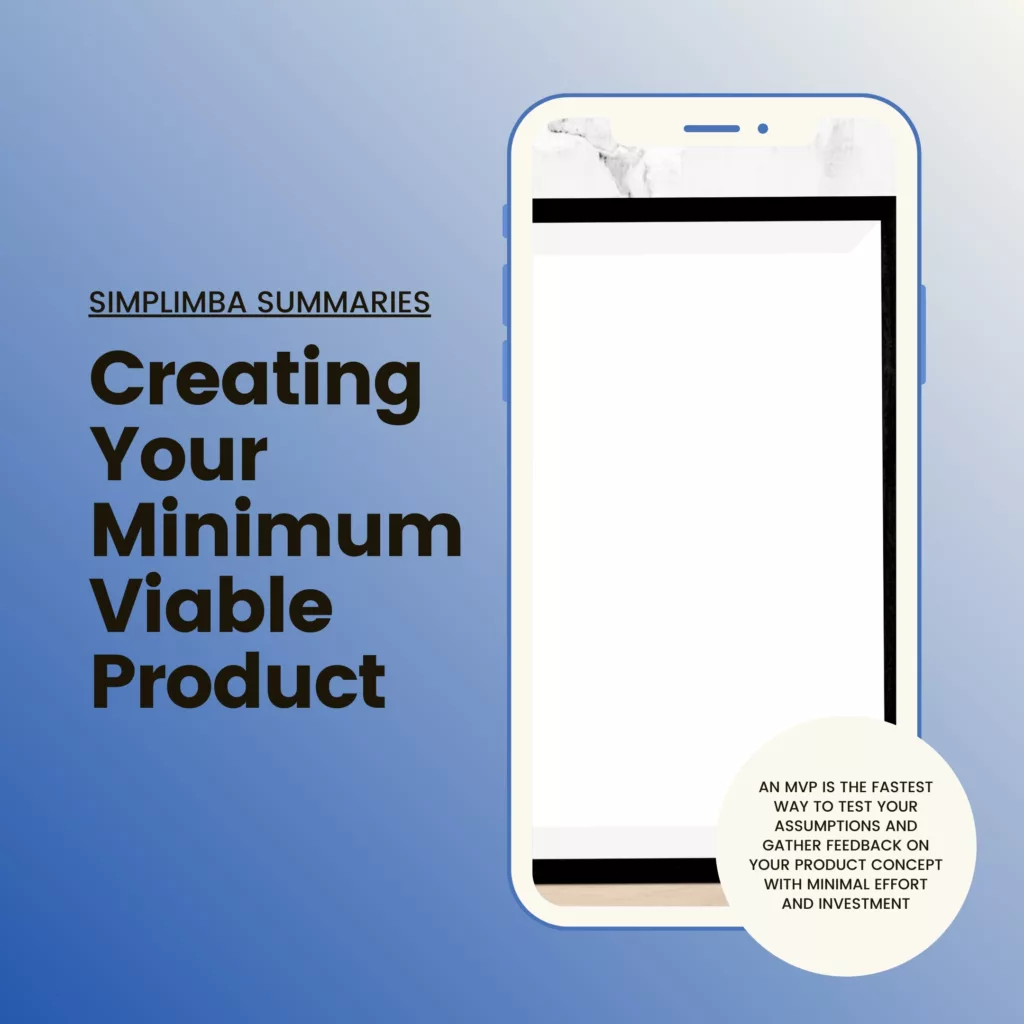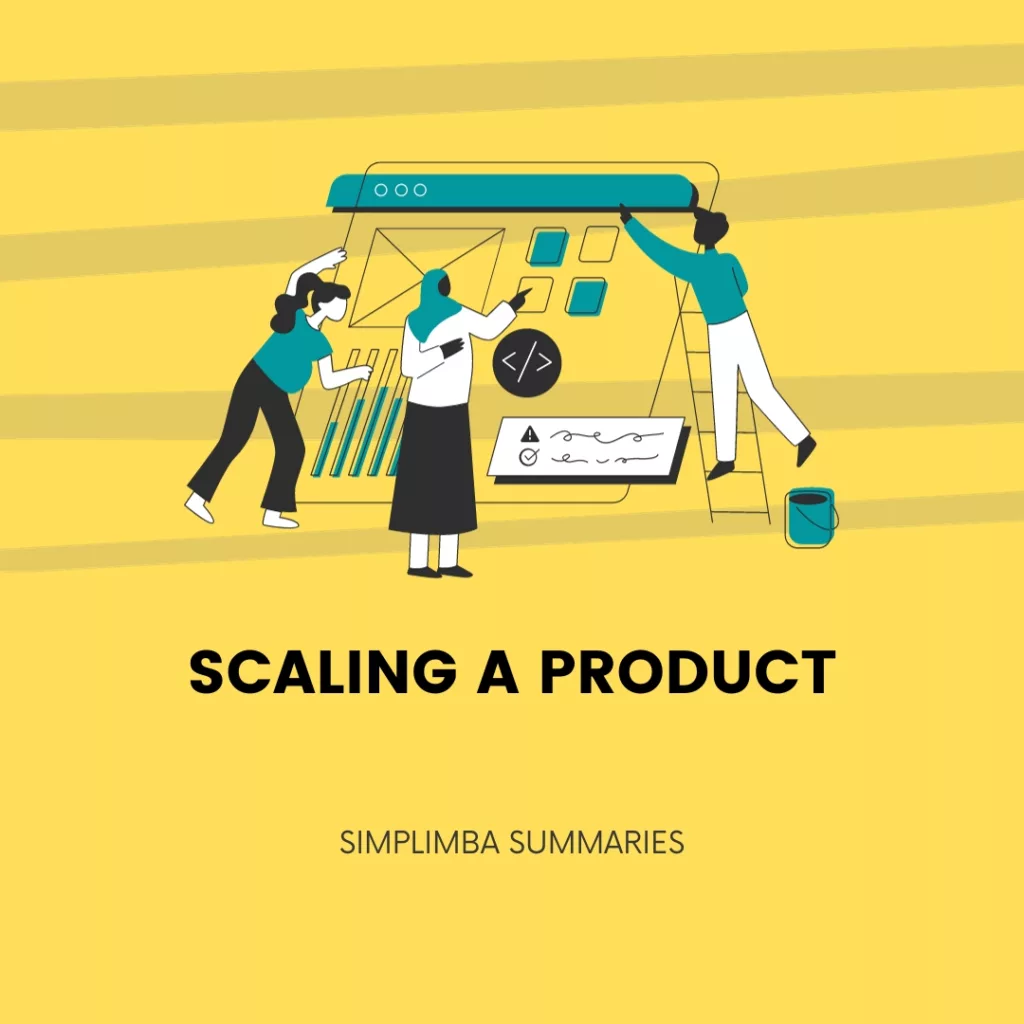Welcome to the book summary of “The Lean Product Playbook” by Dan Olsen. In this comprehensive guide, Olsen shares his expertise in lean product management and provides readers with practical strategies and frameworks for creating successful products. Whether you are a seasoned product manager or just starting out in the field, this book offers valuable insights and actionable advice to help you navigate the complex world of product development.
Olsen begins by introducing the concept of lean product management, which emphasizes continuous learning and iteration. He emphasizes the importance of understanding customer needs and using data to drive decision-making. Throughout the book, Olsen stresses the value of a customer-centric approach, encouraging readers to define their target customers, identify core problems, and create value hypotheses that resonate with their audience.
“The Lean Product Playbook” is filled with real-life examples and case studies, making it easy for readers to apply the concepts discussed to their own product development journey. Olsen shares insights from his own experiences, as well as examples from well-known companies such as Amazon, Netflix, and Airbnb. By combining theory with practical applications, Olsen ensures that readers not only understand the concepts, but also know how to implement them effectively.
So, whether you’re looking to improve your product management skills, create a successful MVP, or scale your product to new heights, this book is your go-to resource. Join us on this journey as we dive deep into each chapter, exploring key concepts, quoting relevant lines from the book, and providing practical examples to help you master the art of lean product management. Let’s get started!
Dan Olsen is an entrepreneur, product management expert, and speaker who has over 20 years of experience in the tech industry. He has worked with a wide range of companies, from small startups to large corporations, helping them build successful products and implement effective product management practices. Olsen is also the founder of Olsen Solutions, a consulting firm that specializes in product management and strategy.
Style of Writing:
Dan Olsen’s writing style in “The Lean Product Playbook” is clear, concise, and practical. He presents complex concepts in a straightforward manner, making it accessible to readers with varying levels of product management experience. Olsen’s writing is authoritative and data-oriented, backed by his extensive industry knowledge and real-life examples.
One of the strengths of Olsen’s writing style is his ability to balance theory with practical application. He provides readers with tangible techniques and frameworks that they can immediately implement in their own product development processes. Whether it’s conducting customer interviews, defining a value hypothesis, or analyzing test results, Olsen breaks down each step into actionable advice.
Another aspect of Olsen’s writing that stands out is his ability to keep readers engaged. He injects a sense of enthusiasm and passion into his writing, making it enjoyable to read. Olsen’s wit and humor shine through, making even complex topics entertaining and relatable. His writing is not only informative but also engaging, keeping readers hooked from start to finish.
Overall, Dan Olsen’s writing style in “The Lean Product Playbook” is authoritative, practical, and engaging. His expertise shines through, and readers will appreciate the clarity and accessibility of his explanations. Whether you’re a seasoned product manager or just starting out, Olsen’s writing will inspire and guide you towards building successful products using the lean methodology.
The Lean Product Playbook: Chapter Wise Summary
Chapter 1: Introduction to Lean Product Management
In the first chapter of “The Lean Product Playbook” by Dan Olsen, the author introduces the concept of lean product management. He explains that lean product management is a systematic approach to creating successful products based on continuous learning and iteration. Olsen highlights the importance of understanding customer needs and using data to drive decision-making. He also provides an overview of the book, which will walk readers through the entire product development process using the lean methodology.
Olsen begins the chapter by quoting Steve Blank, a well-known entrepreneur and academic, who says, “No business plan survives first contact with customers.” This quote sets the tone for the rest of the book, as Olsen emphasizes the importance of understanding customer needs and adapting your product based on real-world feedback.
To illustrate the power of lean product management, Olsen shares the story of Buffer, a social media management tool. He explains that Buffer started as a minimal viable product (MVP) with only a few features and quickly iterated based on user feedback. This approach allowed Buffer to grow and become a successful product, highlighting the effectiveness of the lean methodology.
Olsen outlines the key benefits of lean product management, including reducing the risk of product failure, increasing customer satisfaction, and maximizing return on investment. He emphasizes that the lean approach is not just for startups but can be applied to any size organization.
Throughout the chapter, Olsen provides practical advice and techniques for implementing lean product management. He discusses the importance of conducting customer research, including interviews, surveys, and observation. Olsen suggests creating user personas to better understand and empathize with your target customers. He also introduces the concept of the Build-Measure-Learn feedback loop, emphasizing the importance of quickly testing and iterating on your product.
Chapter 2: Defining Your Target Customer

In this chapter, Olsen focuses on the importance of defining your target customer. He emphasizes the need to understand who your product is designed for and what problem it solves for them. Olsen provides practical advice and techniques for conducting customer research, including interviews, surveys, and observation. He also discusses the concept of creating user personas to better understand and empathize with your target customers.
Olsen begins by stating, “To create a great product, you have to understand your customers. You must know who they are, what they need, and how your product can help them.” He highlights the need for deep customer understanding as the foundation for successful product development.
The author introduces the concept of conducting customer interviews to gain insights. He explains that customer interviews can help uncover pain points, priorities, and preferences. Olsen advises conducting open-ended interviews, where the focus is on listening to the customer and understanding their perspective. He provides a quote from Steve Blank, a renowned entrepreneur, and author, who states, “Get out of the building and talk to people.”
To further illustrate the importance of customer research, Olsen shares an example from the early days of the Dropbox product. The founders of Dropbox conducted interviews with potential customers to understand their file sharing and storage needs. This deep understanding allowed them to create a product that resonated with their target audience and ultimately led to their success.
Olsen also discusses the concept of creating user personas, which are fictional representations of your target customers. He explains that user personas help the product team build empathy and make user-centered decisions. The author provides a quote from Alan Cooper, the pioneer of user personas, who says, “Personas are archetypal users whose goals and characteristics represent the needs of a larger group of users.“
To effectively create user personas, Olsen suggests conducting research to gather demographic information, behavioral patterns, and motivations of your target audience. He provides a step-by-step process for creating user personas, including conducting interviews, synthesizing data, and validating assumptions.
To demonstrate the power of user personas, Olsen shares an example from the video game industry. He explains how the team behind the successful game “World of Warcraft” created user personas to guide their decision-making. By understanding the preferences and motivations of their target audience, they were able to design a game that catered to their needs and desires.
Chapter 3: Identifying the Core Problem

In Chapter 3, Olsen delves into the process of identifying the core problem that your product aims to solve. He encourages readers to conduct problem interviews with potential customers to gain deep insights into their pain points. Olsen offers a step-by-step guide for conducting problem interviews effectively, including tips on asking the right questions and actively listening to customers’ responses. He also highlights the importance of framing the problem in a way that resonates with your target customers.
Olsen begins by highlighting the significance of conducting problem interviews with potential customers to gain deep insights into their pain points. He emphasizes the value of open-ended questions and active listening during these interviews. Olsen states, “The goal is to understand the customer’s perspective and the context of their problem, rather than advocating for your own solution“. This approach allows product managers to uncover the underlying motivations and frustrations experienced by customers.
To illustrate the process, Olsen provides a real-life example of a problem interview conducted by a product manager at LinkedIn. The product manager interviewed users who had recently abandoned the platform to understand their reasons for leaving. Through these interviews, the product manager discovered a common problem: users were unsure of how to derive value from LinkedIn and were overwhelmed by the vast amount of information available. This insight led to the development of a personalized onboarding experience that helped users understand the benefits of the platform and engage more effectively.
Olsen also emphasizes the importance of framing the problem in a way that resonates with the target customers. He suggests using the “problem hypothesis” format, which defines the problem and its impact on the customer. Olsen explains, “By using a problem hypothesis, you clarify the problem and create a testable statement that will guide your solution development efforts”.
Furthermore, Olsen discusses the concept of “job stories” as a useful tool for understanding customer problems. Job stories focus on the context and motivation of the customer, rather than just the task at hand. Olsen cites the example of a job story from Airbnb: “When I suddenly need a place to stay, I want to book a room on Airbnb so that I can feel at home wherever I am”. This job story captures the emotional and practical needs of the customer, allowing product managers to design solutions that address those needs effectively.
Throughout the chapter, Olsen emphasizes the iterative nature of problem identification. He encourages product managers to continuously iterate and refine their understanding of the problem based on customer feedback. Olsen states, “Understanding the problem is an ongoing pursuit that you should continuously refine over time“.
Chapter 4: Defining Your Value Hypothesis

In this chapter, Olsen explains the concept of a value hypothesis, which is a statement that describes the unique value your product offers to customers. He discusses the importance of differentiating your product from competitors and creating a compelling value proposition. Olsen provides practical tips for defining your value hypothesis, such as focusing on benefits rather than features and validating your assumptions through customer feedback.
Olsen starts by reminding readers that customers choose products based on the value they perceive, which can be a combination of functional, emotional, and social benefits. He emphasizes the need to focus on benefits rather than features when defining the value hypothesis. Olsen states, “To create a compelling value hypothesis, it’s important to identify the unique value your product will deliver to customers“.
To illustrate the process of defining a value hypothesis, Olsen shares the example of Dropbox. He explains that Dropbox’s value proposition revolved around the convenience and ease of file sharing and syncing across devices. By providing a solution that solved a pain point for many users, Dropbox was able to differentiate itself from other file-sharing services in the market.
Olsen also highlights the importance of validating your assumptions through customer feedback. He suggests conducting customer interviews or usability tests to gather insights and refine your value hypothesis. Olsen states, “Make sure you are testing not just the product’s features but also the value the product delivers“.
To further exemplify the process, Olsen shares the story of Keynote, a presentation software developed by Apple. Initially, Apple assumed that Keynote’s features and functionality would be enough to attract customers. However, through customer feedback, they realized that the unique value of Keynote was its intuitive interface and beautiful design, which resonated with creative professionals.
In addition to validating your value hypothesis, Olsen advises continuously iterating and evolving it based on customer feedback. He emphasizes the need to stay open to new insights and adjust your value proposition accordingly. Olsen states, “Your value hypothesis is a living document that should evolve as you learn more about your customers and market“.
Chapter 5: Creating Your Minimum Viable Product (MVP)

Chapter 5 focuses on the process of creating a minimum viable product (MVP), which is a simplified version of your product that allows you to gather feedback and validate assumptions. Olsen shares strategies for determining the scope of your MVP, including prioritizing the most critical features and functionalities. He also provides guidance on designing and building your MVP, emphasizing the need for speed and simplicity.
Olsen begins the chapter by explaining the concept of an MVP and its purpose: “An MVP is the fastest way to test your assumptions and gather feedback on your product concept with minimal effort and investment“. He highlights that an MVP should focus on the core value proposition and be designed to address the primary problem for your target customer.
To determine the scope of your MVP, Olsen advises prioritizing the most critical features and functionalities. He introduces the concept of the “Minimum Marketable Feature” (MMF), which is the smallest set of features that provides value to customers. Olsen states, “The goal is to get the smallest, simplest, and most valuable version of your product in the hands of your customers as quickly as possible”.
The author provides a relevant example of Dropbox, a cloud storage and file synchronization service. Dropbox started with a simple MVP that allowed users to store and share files. The initial version lacked many of the features that would later be added, but it provided enough value to attract early adopters and gather feedback. This feedback allowed Dropbox to iterate and improve its product over time.
Olsen also discusses the importance of designing your MVP for speed and simplicity. He suggests using existing tools and resources as much as possible to minimize development time and costs. Additionally, he emphasizes the need to focus on the user experience and ensure that your MVP is intuitive and easy to use.
Throughout the chapter, Olsen provides practical tips and techniques for creating an MVP. He advises using wireframes, prototypes, or even landing pages to simulate the product experience and gather feedback from potential customers. Olsen also highlights the importance of setting specific success metrics for your MVP, such as user engagement or conversion rates, to measure its effectiveness.
Chapter 6: Testing Your MVP
In this chapter, Olsen discusses the importance of testing your MVP with real customers to gather feedback and validate your assumptions. He introduces the concept of a testable hypothesis and provides examples of different types of tests, such as usability tests, landing page tests, and A/B tests. Olsen emphasizes the iterative nature of testing and encourages readers to use data to guide their decision-making.
Olsen begins by explaining the concept of a testable hypothesis, which is a statement that outlines the assumptions you want to test with your MVP. He provides the following quote from the book:
“A testable hypothesis states a cause-and-effect relationship and states what you expect to happen in a test.”
To illustrate this concept, Olsen shares an example from the book where Dropbox, a file hosting service, tested their hypothesis that users would find value in a simple and seamless file synchronization solution. They developed an MVP that allowed users to easily sync files across multiple devices, and through testing, they were able to confirm their hypothesis and validate the demand for their product.
Next, Olsen explores different types of tests that can be conducted with an MVP. He mentions usability tests, where users are observed while interacting with the product to uncover any usability issues or areas for improvement. He also discusses landing page tests, where a landing page with a call-to-action is created to measure user interest and willingness to take action. Olsen provides the following quote to emphasize the importance of testing:
“Remember, the goal of testing is not just to validate your hypothesis but also to gain insights and learn.”
To illustrate the effectiveness of landing page testing, Olsen presents the example of Airbnb. Before investing in building their platform, the founders created a simple landing page with photos of potential listings and a “Request to Book” button. Through this test, they were able to gauge demand and validate their assumption that people would be willing to rent out their homes. This early validation helped shape the direction of their product development.
Olsen also explores A/B testing, where two different versions of a feature or design are tested to determine which one performs better. He highlights the importance of setting clear success metrics before conducting A/B tests. Olsen provides the following quote:
“By setting a clear success metric, you can make a better decision when analyzing the test results.”
To illustrate the power of A/B testing, Olsen shares the example of LinkedIn testing different variations of their homepage design to improve user engagement. Through testing, they were able to identify the most effective design elements and continuously optimize their product based on data-driven insights.
Chapter 7: Analyzing and Learning from Test Results

Chapter 7 focuses on the analysis and learning phase of the lean product management process. Olsen explains how to interpret and analyze test results effectively, emphasizing the need for objectivity and data-driven decision-making. He provides practical tips for identifying patterns, drawing insights, and adjusting your product strategy based on the results of your tests.
Olsen begins by stating, “Analyzing test results is a critical step in the lean process. It allows you to make informed decisions based on data rather than assumptions”. He highlights the need for objectivity and cautions against confirmation bias, where one tends to only seek out data that confirms pre-existing beliefs.
To effectively analyze test results, Olsen suggests starting by identifying patterns. He advises, “Look for patterns in the data and identify trends that can guide your decision-making“. By identifying consistent patterns, product teams can gain valuable insights into customer preferences and behavior.
Olsen further emphasizes the importance of drawing actionable insights from test results. He writes, “The goal of analysis is to gain insights that you can act upon. Look for learnings that can inform your product strategy and help you make improvements”. By extracting meaningful insights, product teams can make informed decisions on how to iterate and optimize their product.
To illustrate the process of analyzing and learning from test results, Olsen provides a relevant example. He shares the story of a company that conducted usability tests on their mobile app and found that users were struggling to find a particular feature. Upon further analysis, they discovered that the feature was buried in a sub-menu and not easily discoverable. This insight prompted the team to redesign the app’s navigation and improve the discoverability of the feature, resulting in a significant increase in user engagement.
In addition to identifying patterns and drawing insights, Olsen also stresses the importance of adjusting the product strategy based on the test results. He advises, “Don’t be afraid to make changes based on what you learn from your tests. Be agile and responsive to the needs and preferences of your customers“. By being adaptable and making necessary adjustments, product teams can ensure that their product continues to meet customer needs and expectations.
Olsen concludes the chapter by reiterating the iterative nature of the lean product management process. He emphasizes that the analysis and learning phase is not a one-time exercise but an ongoing practice. He states, “Remember, analysis and learning is a continuous process. Keep testing, analyzing, and iterating to achieve product-market fit”.
Chapter 8: Iterating and Optimizing Your Product
In this chapter, Olsen explores the iterative nature of product development and the importance of continuous improvement. He discusses the concept of iteration cycles and provides strategies for prioritizing and implementing changes based on customer feedback. Olsen also addresses common challenges and pitfalls that product teams may encounter during the iteration process and offers practical solutions.
One of the key concepts discussed in this chapter is the iterative nature of product development. Olsen states, “Iteration is at the heart of the lean product management approach. It allows you to continually refine and improve your product based on customer feedback and market insights”. He highlights the importance of embracing feedback as a valuable source of information for making informed decisions and driving product improvements.
Olsen suggests using a combination of qualitative and quantitative data to guide the iteration process. He writes, “Qualitative feedback helps you understand the ‘why’ behind your customers’ actions, while quantitative data provides insights into the ‘what’ and ‘how much‘”. By gathering both types of data, product teams can gain a holistic understanding of customer preferences and behavior, enabling them to make data-driven decisions.
To prioritize and implement changes effectively, Olsen introduces the concept of a backlog. He explains that a backlog is a prioritized list of improvements and new features that need to be addressed in future iterations. Olsen advises, “Focus on the high-value items that will have the greatest impact on customer satisfaction and business results”. By prioritizing based on value, product teams can allocate their resources efficiently and address the most critical areas for improvement.
The author also emphasizes the importance of involving cross-functional teams in the iteration process. Olsen writes, “Collaboration between product managers, designers, engineers, and other stakeholders is crucial for success”. By fostering collaboration, product teams can leverage the expertise and perspectives of different team members, leading to more comprehensive and innovative solutions.
Throughout the chapter, Olsen provides relevant examples to illustrate the concepts discussed. One example he shares is that of Intuit, the company behind TurboTax. He explains how Intuit used iterative development and customer feedback to improve their product. By conducting usability tests, collecting feedback, and implementing changes in subsequent iterations, Intuit was able to significantly enhance the user experience and increase customer satisfaction.
Chapter 9: Scaling Your Product

In the final chapter, Olsen discusses the process of scaling your product and growing your customer base. He covers various strategies for acquiring and retaining customers, including marketing, sales, and customer success. Olsen emphasizes the need for ongoing customer research and highlights the importance of maintaining a customer-centric approach even as you scale.
Olsen starts by discussing the importance of understanding your target market and the key factors that influence customer adoption. He states, “A deep understanding of your target customer and their needs is crucial for scaling your product successfully“. This understanding allows you to tailor your marketing and sales efforts to effectively reach and engage your target audience.
One strategy Olsen suggests for scaling your product is through effective marketing. He mentions that “Marketing plays a critical role in creating awareness and generating demand for your product”. He provides examples of various marketing channels, such as content marketing, search engine optimization (SEO), social media, and paid advertising, and emphasizes the importance of tracking your marketing efforts to measure their effectiveness.
Additionally, Olsen highlights the significance of sales in the scaling process. He states, “Sales is a key driver of growth and revenue for your product”. He discusses the importance of having a well-defined sales process, including lead generation, qualification, and closing deals. Olsen also emphasizes the need for ongoing training and support for your sales team to ensure their success.
Customer success is another critical component of scaling your product. Olsen explains that “Customer success focuses on ensuring that your customers achieve their desired outcomes with your product“. He provides examples of customer success activities, such as onboarding, training, and ongoing support, that help customers derive value from your product. Olsen also emphasizes the importance of monitoring customer satisfaction and utilizing feedback to improve your product and customer experience.
Furthermore, Olsen discusses the concept of a growth team, which he defines as “a cross-functional team responsible for driving growth initiatives for your product”. He highlights the need for collaboration between different departments, such as marketing, sales, and customer success, to align their efforts towards achieving growth goals. Olsen provides examples of growth initiatives, such as referral programs and upselling/cross-selling opportunities, that can be implemented by the growth team.
Throughout the chapter, Olsen reiterates the importance of maintaining a customer-centric mindset while scaling your product. He emphasizes the need to continuously gather customer feedback and insights to inform your product improvements and growth strategies. Olsen states, “By staying close to your customers and continuously learning from their experiences, you can ensure that your product evolves to meet their needs”
Samrat is a Delhi-based MBA from the Indian Institute of Management. He is a Strategy, AI, and Marketing Enthusiast and passionately writes about core and emerging topics in Management studies. Reach out to his LinkedIn for a discussion or follow his Quora Page

